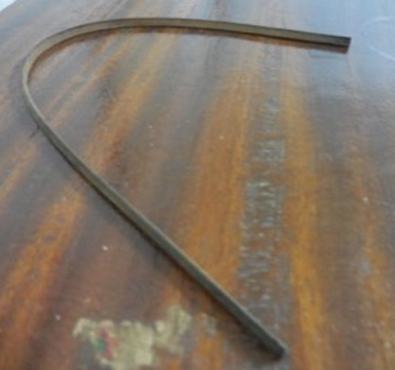Rubber Worms
Susan M. Smith
©
Copyright 2024 by Susan M. Smith

|

Photo courtesy of the author. |
Walking
out the door of my house in Garoua Boulai, Cameroon, I basked in the
morning sun. Not yet too hot. Not too much dust in the air since it
had rained the night before. The air smelled fresh and clean. To the
right of my door grew a huge mango tree with fruit beginning to
ripen. On the packed dirt in front of me, I saw a long, black thing
about two feet long.
A
snake? I knew some lived in the area, and even some poisonous ones,
but I had never seen any. No grass nearby for them to hide. I
approached it cautiously. No movement. Definitely not a snake. It
looked like a long rubber worm. Where had that come from? I picked it
up and took it back inside to the table to examine it further.
Definitely man-made. It had ribbing on one side but I still couldn’t
imagine what it was or why it was on the ground outside.
I
left the mystery and went out to the market as I had originally
planned. My brain pondered the “worm” as I walked along.
On the way home, I noticed that one windshield wiper of my pick-up
truck looked funny. It was only metal. Strange. Suddenly, I realized
that the rubber worm was the part of the wiper that cleaned the
windshield. How had it ended up on the ground? It couldn’t have
fallen out. Who would do that?
Later
that day, I hear cawing from a nearby tree. In it sat two large
birds. They seemed to be more than a foot long and when one started
into the air, the wingspan was a yard across. Initially, they looked
mostly black but on closer inspection I could see a blueish-purple
sheen on the heads, wings, and tails. The breast and sides were
white. The cry sounded like a crow to me. Could crows be that big?
And two colored? As I watched the birds and the ruckus they made,
recognition dawned on me. One of them had “liberated” the
“worm” from the windshield wiper. Was that possible?
Later
that day, I searched on the internet. Pied crows, corvus albus, are
adaptable black and white crows found in sub-Saharan Africa. The size
fit and the location. They are known to steal food from other birds
and nests as well as to scavenge for carrion. They eat just about
everything, including lizards. Pied crows use sticks and even wire to
form their nests which they make each year high in a tree –
like the mango tree beside my house? I laughed. The crazy bird had
liberated the worm and discovered it wasn’t edible spitting it
out on the ground.
The
next day, the other rubber worm from my windshield wiper was on the
ground. Crows, in general, and pied crows, in particular, have a
reputation of using tools, mimicking other sounds, and problem
solving. Either this pied crow wasn’t as intelligent as it was
reputed to be or its mate had gone for the second worm. Maybe the
large truck windshield reflected the sun and made the rubber seem
like a delectable treat.
The
situation was no longer funny. I couldn’t get new windshield
wipers in my town. The nearest store was three hours away. The rainy
season was starting; I couldn’t go anywhere without wipers. I
arranged to have a
friend bring me some
wipers next time he came through town. I began to park the truck
under the overhang next to the house – no sun reflecting off
the windshield and close to the building. And the rains begin in
earnest – perhaps bringing more and better food options. In any
case, no more destroyed windshield wipers.
A
long-time educator, Susan M. Smith, Ph.D., taught for more than 30
years, most of which were with the Pittsburgh Public Schools in the
Spanish Magnet Program, teaching Spanish along with most other
elementary subjects. She was a Peace Corps Volunteer in the Central
African Republic (CAR) in the late 1970s. She returned to CAR from
2012-16 as an Education Adviser for the Evangelical Lutheran Church
of CAR. She also worked on the Refugee, Immigrant, Limited English
Speakers (RIL) Team at the Women’s Center & Shelter of
Greater Pittsburgh for a couple of years. She is now a part-time
interpreter for Hearing & Deaf Services’ PLAN (Pittsburgh
Language Access Network). She is fluent in both Spanish and French.
(Unless
you
type
the
author's name
in
the subject
line
of the message
we
won't know where to send it.)
Book
Case
Home
Page
The
Preservation Foundation, Inc., A Nonprofit Book Publisher



